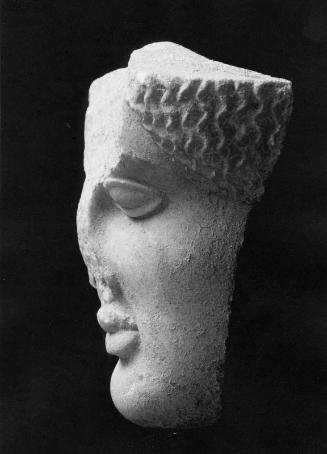Votive relief to Helios and Mên
about 340 B.C.
Place of ManufactureAthens, Attica, Greece
Medium/TechniqueFine-grained Pentelic marble
DimensionsHeight x width: 45 x 44.5 cm (17 11/16 x 17 1/2 in.)
Credit LineFrederick Brown Fund
Accession number1972.78
On View
Not on viewClassificationsSculpture
Collections
ProvenanceBy 1885, Karol Lanckoronski (b. 1848 – d. 1933), Vienna [see note 1]; by descent to his son, Anton Lanckoronski (b. 1893 – d. 1956), Vienna and Zurich; 1939, confiscated with the Lanckoronski collection by the Gestapo (AL 600) [see note 2] and taken to Schloss Immendorf, Austria; September 29, 1943, removed from Schloss Immendorf and taken to Schloss Thürntal, Austria [see note 3]; by about 1947, restituted to Anton Lanckoronski [see note 4]; by descent to his sister, Countess Adelheid (Adelajda) Lanckoronska (b. 1903 – d. 1980), Vienna and Zurich; June 12, 1967, Adelheid Lanckoronska sale, Sotheby’s, London (“Egyptian, Western Asiatic, Greek, Etruscan, Roman, Byzantine and Viking Antiquities"), lot 21, to Herbert A. Cahn (dealer), Münzen und Medaillen, Basel [see note 5]; 1972, sold by Münzen und Medaillen to the MFA. (Accession Date: March 8, 1972)
NOTES:
[1] Count Lanckoronski lent the relief to the Österreichische Museum für Kunst und Industrie in 1885 and the Vienna Archaeological Exhibition of 1893 (no. 1538). See Joanna Winiewicz-Wolska, Karol Lanckoronski and his Viennese Collection (Cracow, 2014), vol. 1, p. 168.
[2] On the fate of the Lanckoronski collection during the National Socialist era and its subsequent restitution, see Winiewicz-Wolska (as above, n. 1), pp. 341 – 403. Because the family claimed Polish citizenship, the art collection was subject to expropriation. The Gestapo confiscated the collection in 1939. This relief was placed on a list of nationally-valuable works of art that were prevented from leaving Austria and made available to Adolf Hitler.
[3] The relief appears on a list of objects from the Lanckoronski collection removed from Schloss Immendorf on September 29, 1943 (“Marmor Weihrelief: Helios u. Men”, no. AL 600) to be taken to Schloss Thürntal. National Archives and Records Administration, College Park, MD, RG 260, Records of U.S. Occupation Headquarters, World War II. Microfilm Publication M1926, Roll 1, Records of the Reparations and Restitutions Branch of the U.S. Allied Commission for Austria (USACA) Section, 1945-1950, Austrian Claims, no. 15. On the movement of Lanckoronski objects to Thürnthal, see Christina Gschiel, " 'Transport der Teile ohne zu schneiden': Die Bergung des Beethoven-Frieses aus derSammlung Lederer in Schloss Thürnthal," in Bergung von Kulturgut im Nationalsozialismus (Vienna, 2016), p. 367. Winiewicz-Wolska (as above, n. 1), p. 376, however, states that there were no antiquities at Thürntal in 1945.
[4] The majority of the collection was restituted to the Lanckoronski family by 1947. Though the relief was returned, in 1950 the authorities once again proposed banning its export from the country. It was ultimately granted an export permit from Austria. See Winiewicz-Wolska (as above, n. 1), p. 392.
[5] Exhibited at Andre Emmerich Gallery, Inc., New York (February 7 - March 13, 1968, Art of the Ancients: Greeks, Etruscans and Romans), cat. no. 44.
NOTES:
[1] Count Lanckoronski lent the relief to the Österreichische Museum für Kunst und Industrie in 1885 and the Vienna Archaeological Exhibition of 1893 (no. 1538). See Joanna Winiewicz-Wolska, Karol Lanckoronski and his Viennese Collection (Cracow, 2014), vol. 1, p. 168.
[2] On the fate of the Lanckoronski collection during the National Socialist era and its subsequent restitution, see Winiewicz-Wolska (as above, n. 1), pp. 341 – 403. Because the family claimed Polish citizenship, the art collection was subject to expropriation. The Gestapo confiscated the collection in 1939. This relief was placed on a list of nationally-valuable works of art that were prevented from leaving Austria and made available to Adolf Hitler.
[3] The relief appears on a list of objects from the Lanckoronski collection removed from Schloss Immendorf on September 29, 1943 (“Marmor Weihrelief: Helios u. Men”, no. AL 600) to be taken to Schloss Thürntal. National Archives and Records Administration, College Park, MD, RG 260, Records of U.S. Occupation Headquarters, World War II. Microfilm Publication M1926, Roll 1, Records of the Reparations and Restitutions Branch of the U.S. Allied Commission for Austria (USACA) Section, 1945-1950, Austrian Claims, no. 15. On the movement of Lanckoronski objects to Thürnthal, see Christina Gschiel, " 'Transport der Teile ohne zu schneiden': Die Bergung des Beethoven-Frieses aus derSammlung Lederer in Schloss Thürnthal," in Bergung von Kulturgut im Nationalsozialismus (Vienna, 2016), p. 367. Winiewicz-Wolska (as above, n. 1), p. 376, however, states that there were no antiquities at Thürntal in 1945.
[4] The majority of the collection was restituted to the Lanckoronski family by 1947. Though the relief was returned, in 1950 the authorities once again proposed banning its export from the country. It was ultimately granted an export permit from Austria. See Winiewicz-Wolska (as above, n. 1), p. 392.
[5] Exhibited at Andre Emmerich Gallery, Inc., New York (February 7 - March 13, 1968, Art of the Ancients: Greeks, Etruscans and Romans), cat. no. 44.
5th century
about 480 B.C.
first half of the 4th century B.C.
about 325–300 B.C.
end of 4th century B.C.
after a type of 475–450 B.C.
A.D. 140–240
second century A.D.
about 2nd century A.D.













